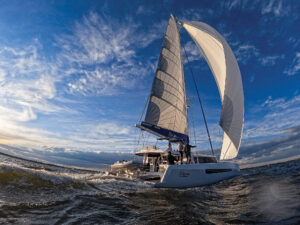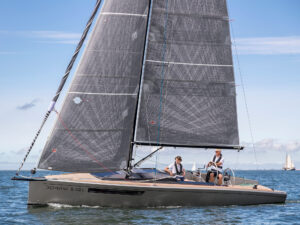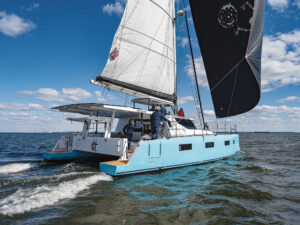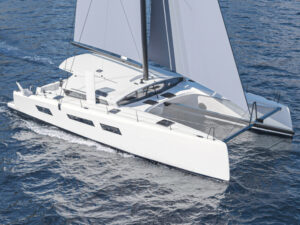
S2 9.2
Within a wide field of well-designed and competitive racer/cruisers of the 1970s, the S2 9.2 stands out, mainly because it wears its age very well. Without a scoop transom and boarding steps or skinny portlights below the sheer, it still looks modern. The flat sheer, sloping deckhouse, almost-flush Lexan forward hatch, hinged anchor lid, and tinted deadlights are familiar features on boats built three decades later. The carefully detailed teak handrails set on molded fiberglass spacers are unobtrusive while emphasizing the hull’s refined shape and unified design. Nothing is exaggerated in the interest of the fashions of the day or to suit a rating rule.
Powerboat builder Leon R. Slikkers founded S2 Yachts in 1974 and commissioned Arthur Edmonds, designer of the Allied Princess 36 and Mistress 39, to design the S2 9.2A (for its aft cockpit) and the S2 9.2C (for its center cockpit). Over 700 A and C models were sold. Both versions have the same hull, fin keel, partially balanced skeg-hung rudder, and masthead sloop rig. The single-spreader aluminum mast, painted black (an S2 trademark) is stepped on deck over a compression post that’s built into the main bulkhead.
The hull is solid, hand-laid fiberglass. It has an inward-turning flange at the sheer to which the balsa-cored deck is bolted through an extruded aluminum toerail. There’s no molded interior liner. Bulkheads and furniture are tabbed to the hull, which contributes to its structural stiffness. Two tons of lead ballast is encapsulated in a sealed keel cavity. Well-cared-for boats show little wear and tear after three decades of hard sailing, and, owners agree, the gelcoat is generally free of stress cracks even where moldings take tight bends.
The T-shaped cockpit is comfortable and workmanlike. The starboard seat opens to general storage and access to the stuffing box and engine controls. Additional storage is located under the helmsman’s seat in twin lazarettes.
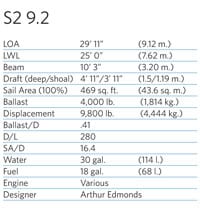
Everything on deck is carefully laid out. The mainsail is sheeted abaft the 28-inch wheel, where it’s out of the way but in reach of the helmsman. The 8-inch stern cleats are mounted on anti-chafing pads and close to hand. Engine controls are similarly convenient to the helm. Early boats had Atomic 4s, but a variety of diesel engines were fitted after 1978.
The engine box provides a wide first step down to the cabin. A small corner galley to starboard of the companionway contains a sink, icebox, and stove. Opposite is a quarter berth and navigation space with a folding seat and table. Headroom is 6 feet 3 inches aft and drops gradually to about 5 feet 10 inches toward the forward cabin.
The saloon table and settee convert to a double berth and, together with a 6-foot-6-inch settee opposite, make a comfortable eating, lounging, and sleeping area. A double berth is located forward of the wardrobe and head area. Generous use of teak, both solid and ply, contributes to a sense of quality throughout the boat, but the polypropylene carpeting used to line the hull ages unattractively.
Sailing the S2 9.2 is a treat. In 15 to 17 knots, it heels sharply under the mainsail and 150-percent genoa before settling in to make 5 or 6 knots upwind. Weather helm is noticeable in stronger gusts, but the boat is generally well balanced and always manageable, even in lumpy seas. All in all, the S2 9.2 is a well-designed, tough, and able 30-footer with good performance for racing or cruising.
Architect Richard Smith and his wife, Beth, sail their Ericson Cruising 31, Kuma, in the Pacific Northwest.
Find more Cruising World boat reviews here.
Read the review of the S2 8.6 here.

